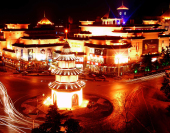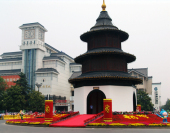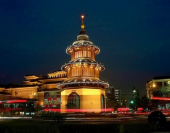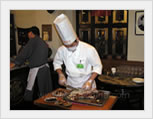
Wenchang Pavilion Guide
-Travel to Wenchang Pavilion Wenchang Pavilion Located in the Wuling Tou of the Xikou Scenic Site. It was built in Year 1731. It was originally a small pavilion with the image of Wenchang God ablated inside, where Wenchang Union, Wenwu Union and Jinxi Study offered sacrifices to God or gathered to discuss literature. In the spring of 1924, when Chiang Kai-shek came back from Guangzhou and found it was going to collapse, he asked Shi Jiangjie and Qing Jiugong to rebuild it, which was not finished until September of the next year. It was a two-story structure with a building area of 500m2.
Wenchang Pavilion Located in the Wuling Tou of the Xikou Scenic Site. It was built in Year 1731. It was originally a small pavilion with the image of Wenchang God ablated inside, where Wenchang Union, Wenwu Union and Jinxi Study offered sacrifices to God or gathered to discuss literature. In the spring of 1924, when Chiang Kai-shek came back from Guangzhou and found it was going to collapse, he asked Shi Jiangjie and Qing Jiugong to rebuild it, which was not finished until September of the next year. It was a two-story structure with a building area of 500m2.
 The platform was laid with rock blocks and the walls were built of blue bricks. Eaves overhang and roof corners are heightened, and girders and frames were carved with characters, flowers and birds. Chiang Kai-shek named it "Le Pavilion (Pavilion of Fun)", and wrote Essay on Le Pavilion that states, "All the people who visited the pavilion were reluctant to leave as they had fun here." But the local people still call it Wenchang Pavilion and call a square pavilion on its east side Le Pavilion. Chiang Kai-shek and his wife Song Meiling used to live here and use it as a place for housing books. In December 1939, it was destroyed on the bombardment of Japanese planes. In April 1987, the government appropriated dedicated fund and rebuilt it according to its original appearance. Now it is a two-story structure with three rooms on each story, divided into main hall, accessory hall and multi-eave or single-eave rooms, with the total building area being 500m2.
The platform was laid with rock blocks and the walls were built of blue bricks. Eaves overhang and roof corners are heightened, and girders and frames were carved with characters, flowers and birds. Chiang Kai-shek named it "Le Pavilion (Pavilion of Fun)", and wrote Essay on Le Pavilion that states, "All the people who visited the pavilion were reluctant to leave as they had fun here." But the local people still call it Wenchang Pavilion and call a square pavilion on its east side Le Pavilion. Chiang Kai-shek and his wife Song Meiling used to live here and use it as a place for housing books. In December 1939, it was destroyed on the bombardment of Japanese planes. In April 1987, the government appropriated dedicated fund and rebuilt it according to its original appearance. Now it is a two-story structure with three rooms on each story, divided into main hall, accessory hall and multi-eave or single-eave rooms, with the total building area being 500m2.
 The rooms are exquisitely decorated and possess a strong traditional Chinese taste with girders, ridgepoles and window lattices finely carved and corridors distributed on all sides. There are exhibitions of painting and calligraphy works inside. The pavilion is covered with many old trees such as camphor trees, goldthread trees, arborvitae and hackberry trees. The rippling Shanxi River is flowing below it. The pavilion, titled Scholarly Pavilion Reaching the Clouds, was already listed as one of the Ten Sight Spots of Xikou in Qing Dynasty. A local celebrity Jiang Tingxiu wrote a poem, "The high hill standing erect has created a good atmosphere for scholarship making; and the auspicious brook has produced many outstanding scholars."
The rooms are exquisitely decorated and possess a strong traditional Chinese taste with girders, ridgepoles and window lattices finely carved and corridors distributed on all sides. There are exhibitions of painting and calligraphy works inside. The pavilion is covered with many old trees such as camphor trees, goldthread trees, arborvitae and hackberry trees. The rippling Shanxi River is flowing below it. The pavilion, titled Scholarly Pavilion Reaching the Clouds, was already listed as one of the Ten Sight Spots of Xikou in Qing Dynasty. A local celebrity Jiang Tingxiu wrote a poem, "The high hill standing erect has created a good atmosphere for scholarship making; and the auspicious brook has produced many outstanding scholars."
More Attractions in Yangzhou
Your Question & Quick Answer*We welcome and appreciate your questions & reviews
Booking Procedures | Terms & Conditions | Payment Methods | Links | Site Map | About Us | Contact Us | Travel Agent
Copyright 2008, All rights reserved.. itourbeijing.com professional china travel guide and china travel service
TEL: 86-10-85711972 (Universal) 1-888-288-9328 (North America) E-mail: contact@itourbeijng.com
Tours Index | China Tours | Beijing Tours | Xi'an Tours | Shanghai Tours | Guilin Tours | Tibet Tours
China Travel | Beijing Travel | Shanghai Travel | Xi'an Travel | Guilin Travel |Beijing Map
China Golf | Beijing Golf | Shanghai Golf | Xiamen Golf | The Great Wall Travel | Yangtze Cruise | Travel Picture



